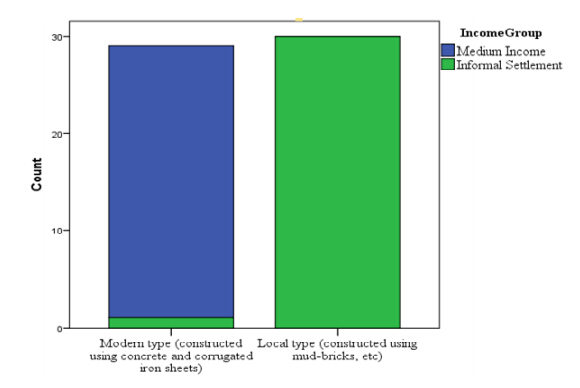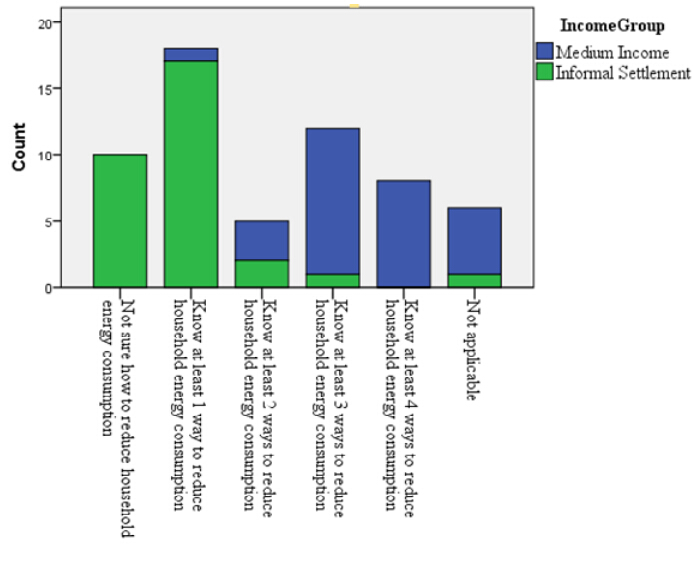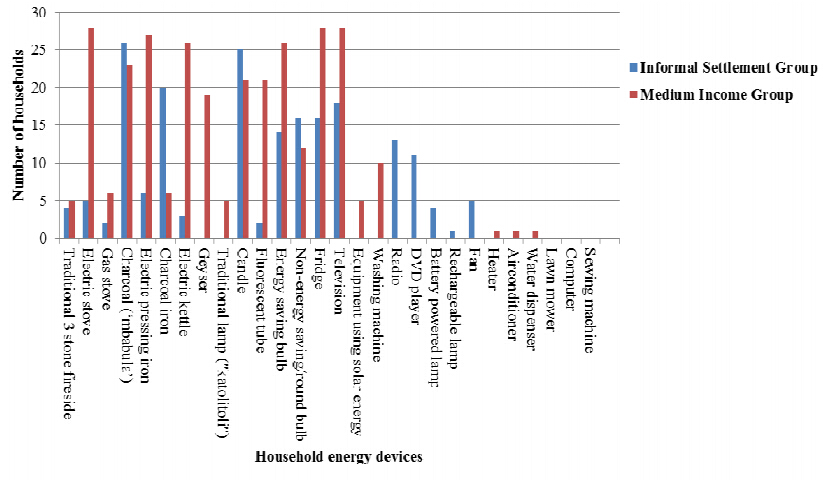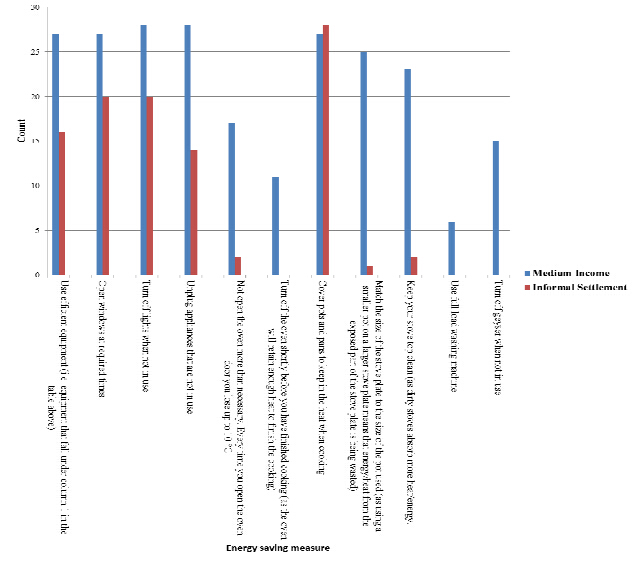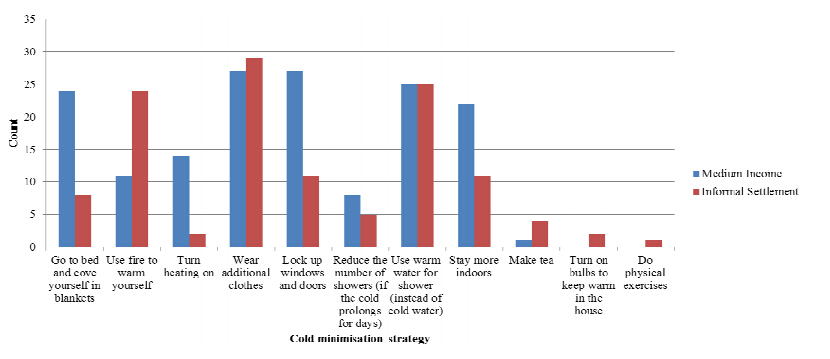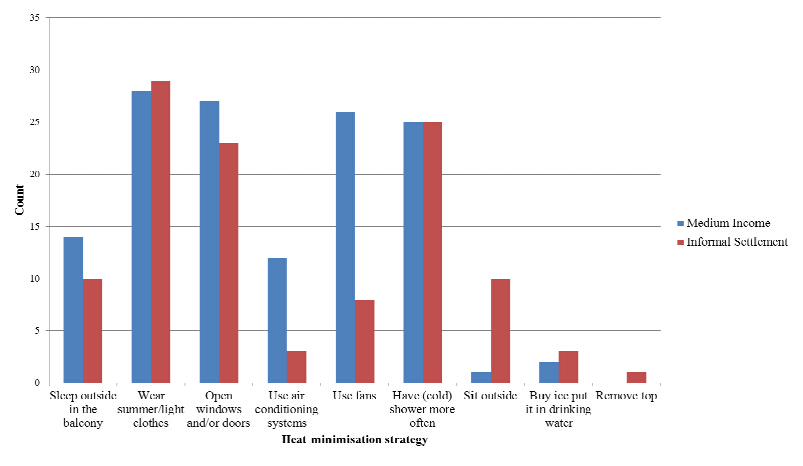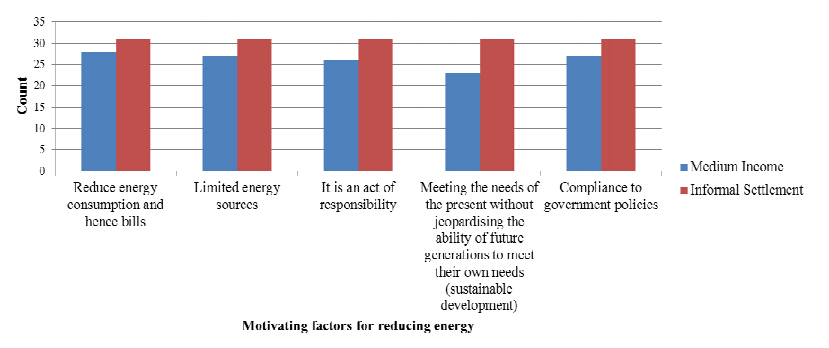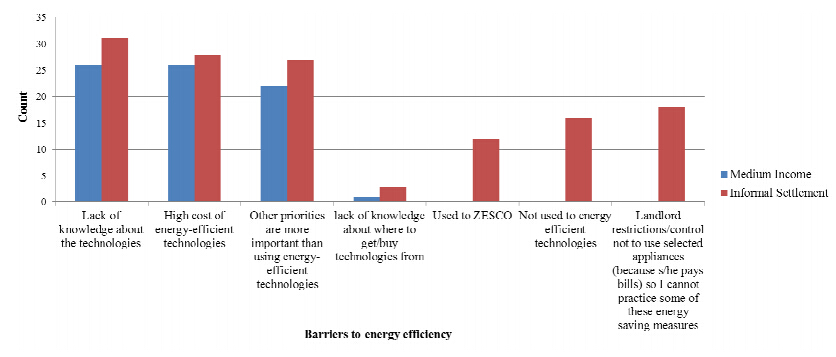1. Introduction
Energy consumption is a subject that has continued to attract widespread debate and attention in both the academia and climate policy, more especially after the 1990s when issues of climate change came to the fore. This debate has particularly been exacerbated by the conflicting nature of the aspirations of the environmentalists and those of the economists. On the one hand , energy consumption is perceived as a sine qua none for economic progress as the exploitation or utilisation of natural resources largely depends on the use of energy. It is in fact common knowledge that energy drives the economies of the world [1] by supporting activities and processes that lead to economic growth. Given that energy is used in a wide range of activities such as manufacturing and buildings as well as various types of appliances therein [2], it follows then that the consumption of resources in generaland energy in particular is critical for economic growth. The scarcity of energy would therefore constrain the socio-economic development of a society [3]. Ab and a [4] states that limited energy or electricity supply would in no time lead to a situation where all government operations and productive systems would come to a halt, thus freezing the entire economy. On the other hand , (excessive) energy consumption has been accused by the ‘environmental movement’ as the very cause of climate change [4]. The challenge for policy makers, researchers and practitioners therefore is to find appropriate levels of energy consumption that would ensure environmental preservation while at the same time achieving economic growth. This requires establishing a fine balance between environmentaland economic arguments such that energy consumption leads to socio-economic development without necessarily violating the need to preserve the environment. The difficulty surrounding the establishment of this ‘fine balance’ is partly due to the fact that the more developed a country becomes, the more energy it requires, and hence the more damage to the environment through, for example, carbon emissions. According to the World Wide Fund for Nature (WWF), an average American, European and African requires 10, 5 and 2.5 hectares of the earth to support their way of life. This is supported by das Gupta [6] and Liu et al. [7] who state that people in modern cities, especially those in China and other currently ‘economically exploding’ countries, are becoming more and more over-consumptive as a result of the desire to establishand /or maintain a high st and ard of life.
What emerges from the foregoing discussion is that there seems to be a correlation between lifestyle and energy consumption, with more affluent societies being likely to consume more energy in order to sustain their affluent lifestyles [2]. Hubacek et al. [5] state that increasing incomes of people lead to increased energy use and more options on how energy can be used, and this choice will determine how the energy sector will be impacted. However, although there is a growing body of research investigating energy consumption and sustainable development, the majority of these studies are more focussed on energy consumption and carbon emissions, and are more biased towards developed at the expense of developing countries (see section 2 below). Thus, there is very little scholarly research on the impact of lifestyles and behaviour patterns on energy consumption. Using a mixed research approach (i.e. a combination of quantitative and qualitative methodologies), this study investigates the lifestyle perceptions, motivations and barriers of households on energy consumption in Kitwe, the second largest city of Zambia. This study is important for purposes of providing empirical data that can not only inform energy policies of developing countries but which can also promote energy consumption practices that allow harmonious coexistence of environmental preservation on one hand and socio-economic development on the other.
2. An overview of related studies
A number of studies on the developed countries have been conducted to analyse and quantify the impact of lifestyle factors on the current and future energy dem and . Yohanis et al. [9] and Yang and Zou [10], for example, have conducted studies to underst and the factors that determine domestic energy consumption. The above studies reveal that domestic energy consumption depends not only on the location and design of a building, but also on the behaviour of the householders. This is also supported by the study done by das Gupta [6]. Das Gupta’s [6] research also revealed that the major stumbling blocks towards promoting the sense of efficiency are the lack of information and awareness by householders, and the lack of monitoring and regulation by relevant authorities. Other scholars like Streimikiene and Mikalauskiene [11] have focused their research on establishing how householders’ behavioural change can reduce energy consumption. The researchers found that the energy saving potential based on behaviour change of consumers was 16.6% in Lithuania. On the basis of this and indeed other researches [6,10], it can be deduced that the behaviour of consumers has a significant impact on the energy consumption levels.
However, Ehrhardt-Martinez’s [12] research revealed that most people are energy-blind because of the limitations of the tools used to quantitatively measure the amounts of energy consumption. For the majority of consumers, the energy bill is the only indicator in both monetary and quantity terms of how much energy they may have consumed in a particular unit of time (often a calendar month). For those with prepaid meters it would be the amount of electricity bought for the month. However, the limitations of these indicators is that they only show the kilowatt-hours (kWh) and the associated costs of electricity consumed; they do not show which appliances or which end-uses dem and the most energy. Furthermore, these indicators do not reveal how change in consumer behaviour can affect dem and . Nevertheless, consumers sometimes adjust their daily behavioural patterns in order to ensure energy efficiency [12]. Arguably, the more knowledgeable people are about the various methods of energy consumption, the more energy efficient they become.
Despite the growing number of studies on energy consumption, these studies are either more focussed on the link between energy consumption and carbon emissions, or are more geographically biased in that they are concentrated on developed countries. Studies addressing the relationship between lifestyle and impacts on energy consumption in developing countries, let alone least developed ones like Zambia, are scarce [3,5,7].
3. Energy consumption in Zambia
Although Zambia is well endowed with indigenous energy resources, the availability of modern energy services to the country’s current population of about 13.1million inhabitants remains an important priority [13,14]. Zambia’s energy sources include electricity, petroleum, coal, biomass, and renewable energy [12]. Among the present sources of energy, wood fuel in the form of charcoaland firewood contributes 79%, electricity 10%, petroleum products 9% and coal 2% of the total consumed energy [14]. While it is self-sufficient in all the other energy resources, Zambia imports petroleum from other countries especially those in the Middle East. The Zambia Development Agency [15] provides that Zambia has solar radiation averaging 5.5 kWh/m²/day with up to 3, 000 sunshine hours annually; providing significant potential for solar thermaland photovoltaic exploitation. Although hydro power is the most important source of electricity in Zambia, there have not been any further major investments in this sector [15]. This is despite the fact that Zambia possesses 40% of the water resources in the Southern African Development Community (SADC)region and has about 6, 000 MW unexploited hydro power potential, while only about 2000 MW has been developed [16]. This, and the poor management which has characterised the main electricity supplier Zambia Electricity Supply Corporation (ZESCO), has led to an energy deficit in Zambia with widespread power outages and an energy-poor rural community, as most of the electricity generated by ZESCO is supplied to urban residents.
Access to electricity in Zambia is reported to be one of the major problems experienced by both urban and rural residents. In 2010, for example, it was revealed by the Central Statistics Office (CSO)of Zambia that only 22% of people in Zambia were connected to electricity. The CSO also reported that electricity connection in rural areas stood at only 5% compared to 53% of urban residents [11]. In terms of usage, energy in Zambia is mainly used for lighting and cooking, with kerosene/paraffin being the main sources of lighting energy. Other lighting sources include candles, electricity, diesel, open fire, torches and solar panels. While use of dieseland open fire has reduced, other sources of lighting energy have increased (see figure 1).
For cooking, it is reported that 54% of households in Zambia use firewood as the main source of cooking energy. Charcoal is the second most used energy source at 29% while electricity is used by 17% of the households. Analysis by rural/urban locations shows that in rural areas, most households use firewood for cooking (84% in 2006 and 81% in 2010), followed by charcoal (14% in 2006 and 16% in 2010) and electricity (2% in 2006 and 3% in 2010). On the contrary, most urban households use charcoal for cooking (51%), followed by electricity (43%), while only a small proportion uses firewood (6%). These urban figures have remained unchanged since 2006 [11].
Zambia has been experiencing positive economic growth in the recent past with an average real GDP growth rate of 5.1% recorded between 2002 and 2009. As a result of expansion in economic activities especially in the mining sector, the peak dem and for electricity in Zambia increased from 1,100 MW in 2001 to 1,600 MW in 2009. The growth in dem and is estimated to be between 150 MW and 200MW per annum by 2015. Given these factors, the dem and for electricity in the country is expected to exceed 2, 000 MW by the year 2015 [17].
Although Zambia has experienced growth in energy dem and over the years, several factors have contributed to the current electricity deficit. These factors include financial constraints, limited training opportunities for personneland limited educational qualifications of staff, transaction costs and tariffs and lack of awareness on renewable energy technologies [14]. Furthermore, the application of a uniform national electricity tariff which is not cost reflective causes investments in rural areas to be unattractive. Inadequate information about available energy resources and applicable technology due to the lack of communication infrastructure, low literacy levels and language barriers have also contributed to the poor performance of the energy sector.
4. Research methodology
This research draws on a combination of quantitative (questionnaire survey) and qualitative methodology (focus group discussions and interviews). Fieldwork was conducted in March 2014 in selected neighbourhoods of Kitwe. Covering an area of 777 km2, and with a 2010 estimated population of slightly over 520, 000 [15], Kitwe is located in the central part of the Copperbelt Province. It is bordered by Kalulushi, Mufulira, Luanshya and Lufwanyama Districts and the city of Ndola. The major economic activity in the city is mining, although agriculture and manufacturing can also be found. Although reliable socio-economic data at neighbourhood level do not exist, the main economic activities in informal settlements include informal trading, charcoal business and working in medium income neighbourhoods like Buyantanshi where majority of the residents are engaged in formal employment in the private sector (particularly mining) and civil service.
Three neighbourhoods―Buyantanshi, Ipusukilo and Musonda―were selected as case study settlements. The neighbourhoods were selected with the aim to capture two different classes of neighbourhoods/residents that can be found in Kitwe, with Buyantanshi representing middle income residents. Ipusukilo and Musonda represented informal settlements, or ‘shanty compounds’ as they are commonly referred to locally. Two settlements were selected to represent informal settlements because it was difficult to identify the physical boundary between the two settlements. The settlements are located close to each other such that some residents are not sure whether they live in Ipusukilo or Musonda. The other criterion used in the selection of the neighbourhoods was ease of access or proximity to the researchers as this helped in minimising research costs, which was key since the research was not funded. As would be expected in a country like Zambia where class formation is prevalent, each of the studied case settlements contained homogeneous respondents in terms of socio-cultural-economic status.
According to the Socialand Community Planning Research [15,18], now known as the National Centre for Social Research (NatCen), in some settings, questionnaire interviews need to be conducted in private for various reasons including in order not to put the respondents at risk of facing disciplinary measures from local administrative structures if the issue under investigation is very sensitive. In the case of the present study, however, it was planned that the questionnaire interviews be conducted in privacy in order to grasp independent opinion as people could speak freely regarding how their behavioural patterns and lifestyle influenced energy consumption. However, it was discovered during fieldwork that group communication ( and not individual communication)was found to be the norm in the informal settlements and as such, although they were not initially planned to be used, mini focus group discussions were used as a supplementary method of data collection―but only in Ipusukilo and Musonda (both informal settlements)where the presence of a ‘stranger’ researcher was found to have the effect of attracting great curiosity from the residents. Because of t he rich social networks, residents in these locations learn about the presence of strangers very quickly. In this study, therefore, opinions on the knowledge and barriers on energy efficiency were normally expressed by families and not individuals. As a result some questionnaire interviews were conducted in the presence of third parties respondents’ relatives and even curious byst and ers. In a way, however, these unplanned mini focus group discussions were serendipitous because the participants were more vibrant, open-minded, and the discussions were more lively and facilitated interjection from other members. This in turn encouraged engagement from the main respondent, as well as deeper probing by the interviewer. Besides, focus group discussions also strengthened triangulation of the evidence thereby facilitating validation/verification of the data.
On the other hand , the situation in Buyantanshi (medium income)was different. Here, respondents preferred to be interviewed individually, with some preferring to complete the questionnaire themselves―although this proved very difficult in some cases as some of the respondents felt bothered with constant follow-up trips to ask them whether they had completed the questionnaire. Given the widespread unwillingness from the Buyantanshi residents to complete the questionnaire, it was decided that the researcher completes the questionnaire whilst having a discussion with the respondent. This approach proved effective as the response rate was better than it would have been if respondents were to complete questionnaires at their own time. A total of 59 respondents were sampled in this study as shown in Table 1.
Table 1. Case study neighbourhoods and respective number of respondents.
| Neighbourhood name | Class | Number of respondents | % | Distance from the Central Business District (CBD) |
| Source: Field survey data, 2014. |
| Buyantanshi | Medium income | 28 | 47.5 | 1 Km |
| Ipusukilo/Musonda | Informal settlement | 31 | 52.5 | 6 Km |
| Total | | 59 | 100 | |
The respondents were sampled using simple random sampling where households were identified through settlement random-walk technique and requested to freely give consent to taking part in the interview. No announcement in the communities was made prior to the field visit. In some cases, snowballing was used where already-interviewed respondents suggested and introduced the survey team to other potential respondents. This technique proved very effective as respondents were found to be more willing to take part in the interview after being introduced by someone they knew, thereby enhancing community acceptance. The decision to stop further sampling in each of the neighbourhoods was reached after reaching a data saturation point―a point where additional respondents did not contribute any new insights to the concept under investigation [20]. A total number of 59 respondents corresponding to 59 homes (28 from medium cost, and 31 from informal settlement)were interviewed.
5. Data analysis
The survey was divided into four parts or sections. Section A was the general information section asking participants to provide information about themselves in terms of occupation of the head of the household, the number of people in the household, their neighbourhood, the type of house in terms of construction materials and the number of bedrooms in the house. Section B was about the knowledge and behaviour about energy efficiency measures of the participants. In this section, participants were asked which types of energy devices they used and to rate them on a scale of one to four in terms of how much energy they thought the devices consume (one represented very low consumption and four very high consumption). Participants were also asked how often they implemented a number of pre-determined energy-saving measures and also what they did when it was cold and hot. Section C sought to determine the motivating factors when deciding to reduce energy, while Section D looked at the barriers hindering or preventing participants from reducing energy consumption.
5.1. General Information about respondents
All the houses in the medium income group were constructed using modern materials and finishes such as concrete blocks, asbestos tiles, corrugated iron sheets. Only 1 out of the 31 houses in the informal settlement was of similar construction. The rest were constructed using local materials and finishes such as mud bricks and thatched roofs. Figure 2 shows these results.
5.2. Knowledge of and behaviour about energy efficiency measures
It has been said that the major stumbling blocks towards promoting energy efficiency are lack of information and awareness among households [6]. The results below confirmed this in the informal settlement where 27 out of the 31 households either knew only one way to reduce energy consumption or did not know at all (Figure 3). In the medium income location however, this was not the case as 23 out of the 28 respondents had some idea about energy reduction, with 11 knowing at least 3 ways and 7 knowing at least 4 ways of reducing energy. The disparity in the number of people that are aware of energy reduction measures between those in the medium income and those in the informal settlement were not captured in the survey but it can be speculated that the disparity could be due to the fact that most of the people in the medium income group are in formal employment And this perhaps gives them an opportunity to have more access to information relating to energy consumption compared to those in the informal settlement. Furthermore, those in formal employment also generally tend to have higher education/literacy levels which can make it easier for them to know more energy consumption reduction measures as these respondents are able to access and read information on energy reduction measures.
Generally, the most used appliances are television, fridge, energy saving bulb, fluorescent bulb, electric kettle, Candle, charcoal, geyser, electric pressing iron and electric stove as shown in Table 2. Of these, the electric stove, electric pressing iron, geyser, energy saving bulb, fridge and television are widely used in the medium income group. While charcoal, charcoal iron, Candle, and non-energy saving bulb are used in informal settlement areas. The results show that energy is mostly used for cooking and lighting in the informal settlements whereas the medium income households include appliances that make life more comfortable as well as for entertainment.
Table 2 presents the distribution of the household’s perception about energy consumption devices. The informal settlement households were of the view that all cooking devices are very high consumption while appliances such as the television, fridge and energy saving bulbs were very low consumption devices. It is also identified that there was very low consumption of charcoaland candles as alternatives to electricity in the medium income group.
Table 2.Perceptions about energy consumption devices.
| | Very low consumption | Low consumption | Moderate consumption | Very high consumption |
| Charcoal ("mbabula") | Informal Settlement | 15.4% | 7.7% | 0.0% | 76.9% |
| Medium Income | 73.9 | 17.4 | 0 | 8.7 |
| Charcoal iron | Informal Settlement | 30.0% | 35.0% | 15.0% | 20.0% |
| Medium Income | 83.3% | 0.0% | 16.7% | 0.0% |
| Candle | Informal Settlement | 56.0% | 28.0% | 4.0% | 12.0% |
| Medium Income | 85.7% | 9.5% | 4.8% | 0.0% |
| Fluorescent bulb | Informal Settlement | 50.0% | 0.0% | 50.0% | 0.0% |
| Medium Income | 38.1% | 52.4% | 4.8% | 4.8% |
| Energy saving bulb | Informal Settlement | 85.7% | 7.1% | 0.0% | 7.1% |
| Medium Income | 42.3% | 30.8% | 11.5% | 15.4% |
| Non-energy saving round bulb | Informal Settlement | 6.3% | 0.0% | 0.0% | 93.7% |
| Medium Income | 33.3% | 16.7% | 41.7% | 8.3% |
| Electric stove | Informal Settlement | 0.0% | 0.0% | 0.0% | 100.0% |
| Medium Income | 14.3% | 10.7% | 14.3% | 60.7% |
| Electric pressing iron | Informal Settlement | 16.7% | 0.0% | 16.7% | 66.7% |
| Medium Income | 22.2% | 7.4% | 37.0% | 33.3% |
| Electric kettle | Informal Settlement | 0.0% | 0.0% | 0.0% | 100.0% |
| Medium Income | 42.3% | 15.4% | 15.4% | 26.9% |
| Geyser | Informal Settlement | 0.0% | 0.0% | 0.0% | 0.0% |
| Medium Income | 15.8% | 21.1% | 26.3% | 36.8% |
| Fridge | Informal Settlement | 93.8% | 0.0% | 0.0% | 6.2% |
| Medium Income | 35.7% | 10.7% | 39.3% | 14.3% |
| Television | Informal Settlement | 94.4% | 0.0% | 0.0% | 5.6% |
| Medium Income | 32.1% | 39.3% | 21.4% | 7.1% |
Households were asked which energy saving measures they implemented and how often. The results show that the medium income households turned off lights and unplugged appliances mostly. For the informal settlement households, it was covering pots and pans when cooking that was mostly cited as the energy saving measure implemented (Table 3). However, it should be noted that 50% of respondents in informal settlement who cover pots and pans as an energy conservation strategy also did so for hygienic reasons.
Table 3. Comparison of energy saving measures between the informal settlement and medium income group.
| | Very often | Often | Less often | Never |
| In this paper the acronyms MI and IS st and for medium income and informal settlement, respectively. |
| Use efficient equipment | MI | 21 | 67.7% | 4 | 80.0% | 4 | 40.0% | 0 | 0.0% |
| IS | 10 | 32.3% | 1 | 20.0% | 6 | 60.0% | 2 | 100.0% |
| | 31 | | 5 | | 10 | | 2 | |
| Open windows at required times | MI | 23 | 65.7% | 4 | 44.4% | 0 | 0.0% | 0 | 0.0% |
| IS | 12 | 34.3% | 5 | 55.6% | 3 | 100.0% | 0 | 0.0% |
| | 35 | | 9 | | 3 | | 0 | |
| Turn off lights when not in use | MI | 22 | 53.7% | 5 | 83.3% | 1 | 100.0% | 0 | 0.0% |
| IS | 19 | 46.3% | 1 | 16.7% | 0 | 0.0% | 1 | 100.0% |
| | 41 | | 6 | | 1 | | 1 | |
| Unplug appliances that are not in use | MI | 15 | 62.5% | 11 | 68.8% | 2 | 100.0% | 0 | 0.0% |
| IS | 9 | 37.5% | 5 | 0.3% | 0 | 0.0% | 5 | 100.0% |
| | 24 | | 16 | | 2 | | 5 | |
| Cover pots and pans to keep in the heat when cooking | MI | 22 | 47.8% | 5 | 71.4% | 0 | 0.0% | 0 | 0.0% |
| IS | 24 | 52.2% | 2 | 28.6% | 2 | 100.0% | 1 | 100.0% |
| | 46 | | 7 | | 2 | | 1 | |
Apart from being used for cooking and lighting, energy is also used to either keep people warm in winter or cool in the summer. However, not all keeping cool or warm strategies require energy as shown in Figures 6 and 7 and Tables 4 and 5. Wearing additional clothes to keep warm was chosen as the cold-minimisation strategy by most respondents in both the informal settlement and the medium income area. The comparison in Table 4shows that these results were almost evenly distributed with informal settlements at 54.9% and the medium cost with 45.1%. The respondents in both the informal settlement and the medium income also selected using warm water for their bath to keep warm.
Table 4.Most significant cold minimisation strategy.
| | Very often | Often | Less often | Not often | |
| Go to bed and cover yourself in blankets | MI | 7 | 70.0% | 9 | 100.0% | 8 | 61.5% | 2 | 28.6% |
| IS | 3 | 30.0% | 0 | 0.0% | 5 | 38.5% | 5 | 71.4% |
| | 10 | | 9 | | 13 | | 7 | |
| Use fire to warm yourself | MI | 1 | 5.0% | 2 | 50.0% | 8 | 72.7% | 4 | 44.4% |
| IS | 19 | 95.0% | 2 | 50.0% | 3 | 27.3% | 5 | 55.6% |
| | 20 | | 4 | | 11 | | 9 | |
| Turn heating on | MI | 2 | 66.7% | 11 | 91.7% | 1 | 100.0% | 6 | 75.0% |
| IS | 1 | 33.3% | 1 | 8.3% | 0 | 0.0% | 2 | 25.0% |
| | 3 | | 12 | | 1 | | 8 | |
| Wear additional clothes | MI | 23 | 45.1% | 4 | 80.0% | 0 | 0.0% | 1 | 33.3% |
| IS | 28 | 54.9% | 1 | 20.0% | 0 | 0.0% | 2 | 66.7% |
| | 51 | | 5 | | 0 | | 3 | |
| MI | 13 | 72.2% | 10 | 71.4% | 4 | 66.7% | 0 | 0.0% |
| Lock up windows and doors | IS | 5 | 27.8% | 4 | 28.6% | 2 | 33.3% | 7 | 100.0% |
| 18 | | 14 | | 6 | | 7 | |
| MI | 2 | 66.7% | 4 | 66.7% | 2 | 50.0% | 6 | 33.3% |
| Reduce the number of showers (if the cold prolongs for days) | IS | 1 | 33.3% | 2 | 33.3% | 2 | 50.0% | 12 | 66.7% |
| 3 | | 6 | | 4 | | 18 | |
| MI | 20 | 51.3% | 2 | 40.0% | 3 | 50.0% | 2 | 100.0% |
| Use warm water for shower (instead of cold water) | IS | 19 | 48.7% | 3 | 60.0% | 3 | 50.0% | 0 | 0.0% |
| 39 | | 5 | | 6 | | 2 | |
| MI | 12 | 70.6% | 9 | 69.2% | 1 | 33.3% | 0 | 0.0% |
| Stay more indoors | IS | 5 | 29.4% | 4 | 30.8% | 2 | 66.7% | 0 | 0.0% |
| 17 | | 13 | | 3 | | 0 | |
Similarly, keeping cool in summer was mostly done by wearing light summer clothes by respondents in both the informal settlement and medium income area, a strategy that does not require energy use. Opening windows and having cold showers were also used to keep cool in both areas by most respondents.
5.3. Motivation or rationale for embracing energy efficiency measures
Participants were asked which factors were significant in motivating their decisions to reduce energy consumption. The informal settlement households stated that all the factors were reasons for reducing energy and were equally ranked. In the medium income group, the highest ranking reasons were reducing the energy consumption and hence bills, and compliance to government policies. Meeting the needs of the present without jeopardising the ability of future generations to meet their own needs was the lowest ranked. Figure 8 and Table 6 present the results obtained in the survey.
5.4. Barriers to the uptake of energy efficiency measures
Lack of knowledge about energy efficiency can hinder households from adopting and employing energy reduction strategies. Although many respondents had an idea about energy
Table 5. Detailed heat minimisation strategy.
| | Very often | Often | Less often | Not often |
| Sleep outside in the balcony | MI | 1 | 25.0% | 0 | 0 | 1 | 50.0% | 12 | 85.7% |
| IS | 3 | 75.0% | 4 | 100 | 1 | 50.0% | 2 | 14.3% |
| | 4 | | 4 | | 2 | | 14 | |
| Wear summer/light clothes | MI | 24 | 46.2% | 2 | 66.7% | 0 | 0.0% | 2 | 100.0% |
| IS | 28 | 53.8% | 1 | 33.3% | 0 | 0.0% | 0 | 0.0% |
| | 52 | | 3 | | 0 | | 2 | |
| Open windows and /or doors | MI | 26 | 56.5% | 1 | 50.0% | 0 | 0.0% | 0 | 0.0% |
| IS | 20 | 43.5% | 1 | 50.0% | 0 | 0.0% | 2 | 100.0% |
| | 46 | | 2 | | 0 | | 2 | |
| Use air conditioning systems | MI | 4 | 100.0% | 1 | 100.0% | 2 | 100.0% | 5 | 62.5% |
| IS | 0 | 0.0% | 0 | 0.0% | 0 | 0.0% | 3 | 37.5% |
| | 4 | | 1 | | 2 | | 8 | |
| Use fans | MI | 20 | 83.3% | 2 | 66.7% | 2 | 66.7% | 2 | 50.0% |
| IS | 4 | 16.7% | 1 | 33.3% | 1 | 33.3% | 2 | 50.0% |
| | 24 | | 3 | | 3 | | 4 | |
| MI | 15 | 40.5% | 9 | 90% | 0 | 0% | 1 | 50% |
| Have (cold)shower more often | IS | 22 | 59.5% | 1 | 10% | 1 | 100% | 1 | 50% |
| | 37 | | 10 | | 1 | | 2 | |
| MI | 1 | 12.5% | 0 | 0% | 3 | 75% | 0 | 0% |
| Sit outside | IS | 7 | 87.5% | 2 | 100% | 1 | 25% | 1 | 100% |
| | 8 | | 2 | | 4 | | 1 | |
reduction all of the households in the informal settlement and 26 out of the 28 in the medium income group cited lack of knowledge about energy efficient technologies as a barrier. However, lack of knowledge about where to purchase these energy reduction technologies was not considered a barrier as only 3 out of 31 of the informal settlement households and 1 out of 28 of the medium income households cited it as a barrier.
Table 6. Energy reduction motivating factors.
| | | Highly significant | Significant | Less significant | Not significant |
| Reduce energy consumption and hence bills | MI | 23 | 56.1% | 2 | 100.0% | 2 | 100.0% | 1 | 7.1% |
| IS | 18 | 43.9% | 0 | 0.0% | 0 | 0.0% | 13 | 92.9% |
| | 41 | | 2 | | 2 | | 14 | |
| Limited energy sources | MI | 7 | 100.0% | 16 | 100.0% | 3 | 42.3% | 1 | 3.6% |
| IS | 0 | 0.0% | 0 | 0.0% | 4 | 57.1% | 27 | 96.4% |
| | 7 | | 16 | | 7 | | 28 | |
| It is an act of responsibility | MI | 16 | 100.0% | 8 | 80.0% | 2 | 50.0% | 0 | 0.0% |
| IS | 0 | 0.0% | 2 | 20.0% | 2 | 50.0% | 27 | 100.0% |
| | 16 | | 10 | | 4 | | 27 | |
| Meeting the needs of the present without jeopardising the ability of future generations to meet their own needs (sustainable development) | MI | 7 | 100.0% | 3 | 100.0% | 5 | 83.3% | 8 | 21.1% |
| IS | 0 | 0.0% | 0 | 0.0% | 1 | 16.7% | 30 | 78.9% |
| | 7 | | 3 | | 6 | | 38 | |
| Compliance to government policies | MI | 7 | 100.0% | 11 | 100.0% | 5 | 83.3% | 4 | 11.8% |
| IS | 0 | 0.0% | 0 | 0.0% | 1 | 16.7% | 30 | 88.2% |
| | 7 | | 11 | | 6 | | 34 | |
Table 7. Detailed barriers to the uptake of energy efficiency measures.
| | Highly significant | Significant | Less significant | Not significant |
| Lack of knowledge about the technologies | MI | 7 | 77.8% | 6 | 46.2% | 6 | 40.0% | 7 | 35.0% |
| IS | 2 | 22.2% | 7 | 53.8% | 9 | 60.0% | 13 | 65.0% |
| | 9 | | 13 | | 15 | | 20 | |
| High cost of energy-efficient technologies | MI | 8 | 44.4% | 8 | 88.9% | 6 | 40.0% | 4 | 33.3% |
| IS | 10 | 55.6% | 1 | 11.1% | 9 | 60.0% | 8 | 66.7% |
| | 18 | | 9 | | 15 | | 12 | |
| Other priorities are more important than using energy-efficient technologies | MI | 2 | 40.0% | 11 | 100.0% | 4 | 44.4% | 5 | 20.8% |
| IS | 3 | 60.0% | 0 | 0.0% | 5 | 55.6% | 19 | 79.2% |
| | 5 | | 11 | | 9 | | 24 | |
| lack of knowledge about where to get/buy technologies from | MI | 0 | 0.0% | 0 | 0.0% | 1 | 100.0% | 0 | 0.0% |
| IS | 1 | 100.0% | 0 | 0.0% | 0 | 0.0% | 2 | 100.0% |
| | 1 | | 0 | | 1 | | 2 | |
| Used to ZESCO | MI | 0 | 0.0% | 0 | 0.0% | 0 | 0.0% | 0 | 0.0% |
| IS | 1 | 100.0% | 0 | 0.0% | 0 | 0.0% | 2 | 100.0% |
| | 1 | | 0 | | 0 | | 2 | |
| Not used to energy efficient technologies | MI | 0 | 0.0% | 0 | 0.0% | 0 | 0.0% | 0 | 0.0% |
| IS | 10 | 100.0% | 0 | 0.0% | 0 | 0.0% | 2 | 100.0% |
| | 10 | | 0 | | 0 | | 2 | |
| landord restrictions/control not to use selected appliances (because s/he pays bills)so I cannot practice some of these energy saving measures | MI | 0 | 0 | 0 | 0 | 0 | 0 | 0 | 0 |
| IS | 13 | 100.0% | 0 | 0.0% | 0 | 0.0% | 5 | 100.0% |
| | 13 | | 0 | | 0 | | 5 | |
With high levels of poverty in developing countries, it would be expected that energy efficiency measures would not be an important priority. However, 79.2% of the informal settlement respondents stated that although other priorities are more important than using energy efficient technologies, this was not a significant barrier. Interestingly, this study reveals traces of resistance to change as 11 respondents in the informal settlement preferred to use electricity provided by ZESCO (the national electricity supplier)than try other energy efficient technologies. They were of the view that they were used to ZESCO and thus could not use alternatives. The research also revealed that landord control in the informal settlements was a highly significant barrier to using energy efficient technologies. This is because some households used electricity that had been connected from a main house to an extension or st and -alone house within the same yard and not from the service provider. This meant that the household in the extension or second house used the electricity prepaid meter in the primary house. Therefore the landord was responsible for buying of the credit for all the households within the yard. Some landords therefore included an amount in the rent to cater for the electricity. Thus the landord would not allow the tenants to use certain electric appliances like stoves and pressing irons as they believed that these appliances consumed too much electricity. This ‘landord control’ had the effect of preventing the households from adopting energy efficient technologies.
6. Key findings and discussion
The results obtained in the study show that: (1)16.9% (10 out of a combined 59 households)did not know how to reduce household energy consumption, indicating some level of household awareness and knowledge on energy efficiency. (2)Covering pots and pans when cooking to retain the heat, opening windows and turning off lights in rooms not in use were the mostly cited energy saving measures―although the majority of respondents in informal settlements were covering pots/pans when cooking for hygiene purposes and not as an energy serving measure. (3)Wearing additional clothes in winter and light clothes in summer were ranked highest in terms of cold and heat reduction by households in both groups. However, using warm water and using fans followed closely behind, showing a significant amount of energy required to keep warm or cool. (4)Although the households had reasons to embrace energy saving measures, the lack of awareness and cost of technology were significant barriers. This shows a willingness to reduce energy consumption but households were discouraged by the barriers. It is therefore suggested that cheaper technologies and innovations be promoted and encouraged. Also, governments should step up the efforts to sensitise the public about energy efficiency and the benefits of energy reduction.
7. Conclusion
This study investigated the perceptions of different lifestyles on energy consumption in the city of Kitwe (Zambia). Data was collected from 31 questionnaires, representing 31 households in two informal settlements and 28 questionnaires representing 28 households in a medium income area. Although most households knew at least one way to reduce household energy consumption, lack of knowledge about this was considered a significant barrier to energy efficiency. With high levels of poverty in developing countries, it would be expected that energy efficiency measures would not be an important priority. However, most of the informal settlement respondents stated that although other priorities are more important than using energy efficient technologies, this was not a significant barrier. The study also revealed that more households were aware of energy reduction in the medium income area compared to households in the informal settlement.
This was a preliminary study which sought to explore the perceptions of households on energy efficiency and consumption. Thus a number of aspects were investigated, that is, energy devices used, knowledge of energy efficiency, motivations and barriers. Further research should be conducted to determine tangible benefits of energy efficiency. Such tangible benefits will include quantitative impacts of behaviour change, an aspect where there is currently a paucity of literature. With such information being made available to households, more will adopt energy efficiency strategies as they will have more motivation to overcome the barriers.
Conflict of Interest
The authors declare that there are no conflicts of interest related to this study.









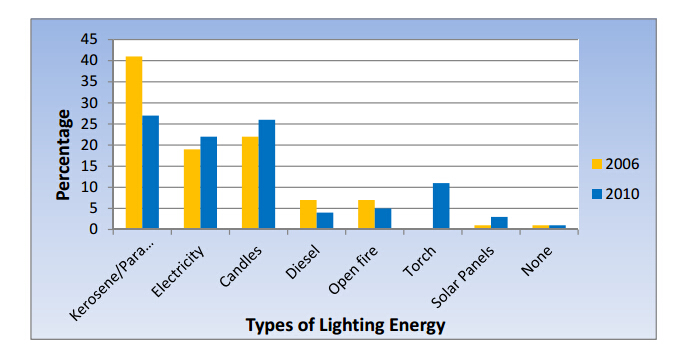
 DownLoad:
DownLoad: 